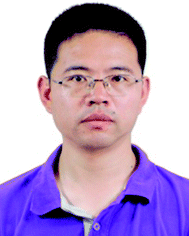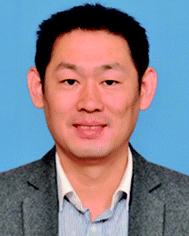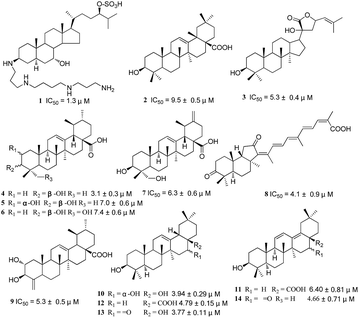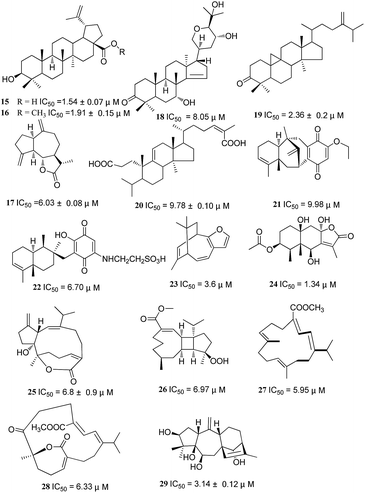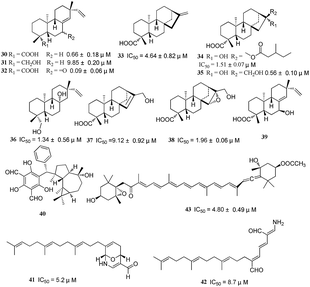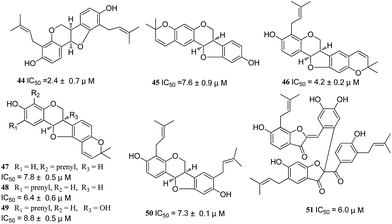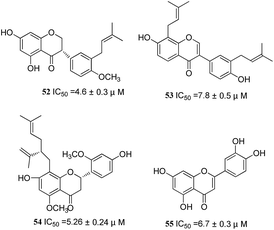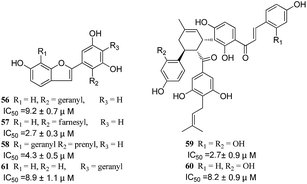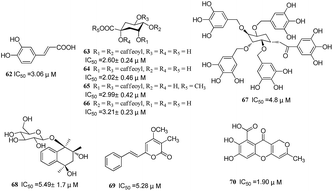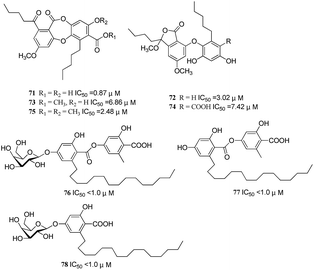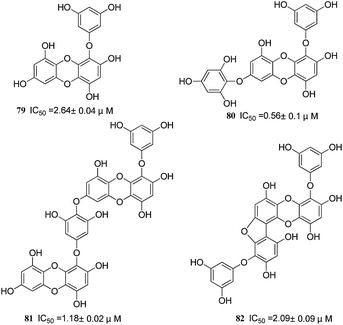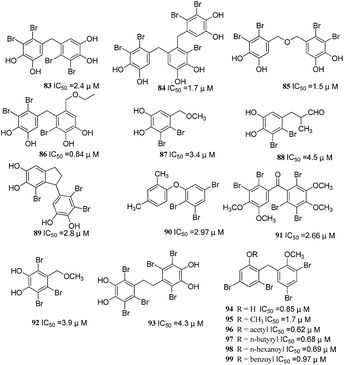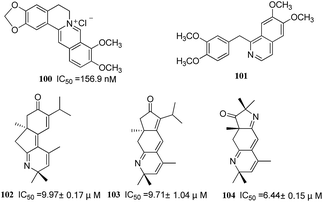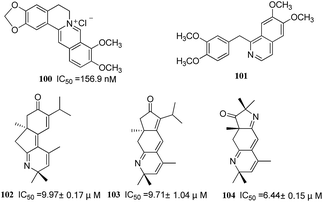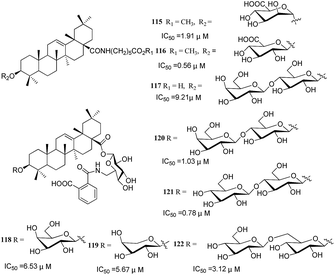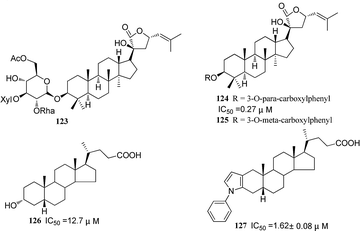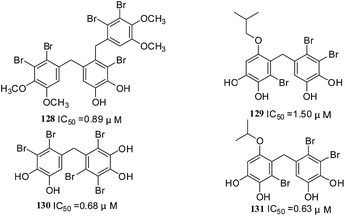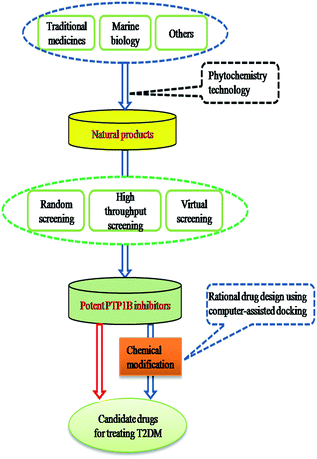Natural and semisynthetic protein tyrosine phosphatase 1B (PTP1B) inhibitors as anti-diabetic agents
Li-Jun Wang
,
Bo Jiang,
Ning Wu,
Shuai-Yu Wang and
Da-Yong Shi
*
Institute of Oceanology, Chinese Academy of Sciences, 7 Nanhai road, 266071, Qingdao, China. E-mail: shidayong@qdio.ac.cn; Fax: +86 532 82898719; Tel: +86 532 82898719
First published on 27th May 2015
Abstract
Diabetes mellitus, which includes both type 1 and type 2 diabetes mellitus (T2DM), is a major disease that threatens human health worldwide. Protein tyrosine phosphatase 1B (PTP1B) is a promising molecular-level therapeutic target that is effective in the management of T2DM. Natural products with various skeletons and diverse bioactivities offer opportunities for the development of new drugs and lead compounds with potent inhibitory activity against PTP1B in vitro and in vivo. Recently, a number of potent PTP1B inhibitors have been obtained from natural sources or prepared by synthesis/semi-synthesis, and they exhibit potential for the treatment of T2DM. In this review, we discuss the development of potent natural and semisynthetic PTP1B inhibitors with IC50 values under 10 μM over the past six years (2009–2014), including their structural features, biological features, structure–activity relationships (SARs). We also discuss strategies for identifying potent PTP1B inhibitors from natural products to provide useful information for use by medicinal chemists in developing potent PTP1B inhibitors as T2DM treatments.
1 Introduction
Diabetes mellitus is a chronic disease that results from insulin deficiency or insulin resistance. Diabetes mellitus is the main threat to human health worldwide.1,2 The prevalence of the disease is constantly increasing, with approximately 347 million individuals suffering from diabetes and more than 3 million deaths per year from consequences of uncontrolled hyperglycaemia, according to World Health Organization (WHO) reports.3 There are two main types of diabetes: type 1 and type 2 diabetes mellitus (T2DM). T2DM is noninsulin-dependent diabetes mellitus and is characterized by defects in signalling by the insulin receptor (IR) protein tyrosine kinase, and accounts for 90% of cases of diabetes.4,5 Women, particularly those with a history of gestational diabetes, usually acquire this disease. Accumulating evidence has shown a strong association between childhood obesity and the onset of diabetes.6 Moreover, obesity is a major risk factor, and approximately 75% of obese individuals develop T2DM.7 In addition, this disease causes many severe secondary complications, including atherosclerosis, microangiopathy, renal dysfunction and failure, cardiac abnormalities, diabetic retinopathy, and ocular disorders.8,9 Thus, developing novel therapies to treat these diseases is essential.Currently, eight oral hypoglycaemic drug classes are available to treat patients suffering from T2DM. Classified according to their mechanisms of action, they are (i) a-glucosidase inhibitors, (ii) insulin secretagogues, (iii) biguanides, (iv) thiazolidinediones, (v) glucagon-like peptide-1 (GLP-1) receptor agonists, (vi) dipeptidyl peptidase-4 (DPP-4) inhibitors, (vii) sodium-glucose cotransporter-2 (SGLT2) inhibitors and (viii) amylin analogs.10 Although hypoglycaemic agents are widely available, these agents show many limitations, including adverse effects (e.g., gastrointestinal complaints, weight gain, peripheral oedema, headache, hypotension) and high rates of secondary failure, because they are not mimetic of insulin signaling.11 Thus, novel drugs that mimic only the desired properties of insulin signalling are urgently needed.12 Protein tyrosine phosphatases (PTPs) are enzymes that catalyze protein tyrosine dephosphorylation, which plays a key role in the regulation of insulin action by dephosphorylation of the activated autophosphorylated IR and downstream substrate proteins.13 Animal models, clinical studies and cell line studies have shown that a cytosolic non-receptor PTP, protein tyrosine phosphatase 1B (PTP1B), is a negative regulator of insulin signal transduction, and it has proven to be an important molecular target for potential treatment of T2DM.14–18
A number of PTP1B inhibitors have been synthesized as promising candidates for the treatment of T2DM since the late 1990s, including phosphonic acid, phosphonodifluoromethyl phenylalanine derivatives, carboxylic acids, imides, sulphonic acids and vanadium compounds. These efforts focused on designing non-hydrolyzable p-Tyr surrogates that target the catalytic site, the second allosteric pocket or both catalytic and allosteric sites.19,20 However, these molecules still lack efficacy in vivo because they have weak oral bioavailability, poor membrane permeability and weak selectivity over other PTPs.
It is well known that natural products with various skeletons and diverse bioactivities offer more opportunities for the development of new drugs and lead compounds.21 It has been proven that natural products are the most important sources for potential and novel PTP1B agents based on different in vitro and in vivo approaches. Many potent and specific natural PTP1B inhibitors with the potential to improve insulin resistance and normalize plasma glucose and insulin without inducing hypoglycaemia have been reported.22–24 Trodusquemine (MSI-1436, 1, Fig. 1), which has an IC50 value of 1.3 μM against PTP1B, is a natural novel aminosterol originally isolated from the liver of the dog fish shark (Squalus acanthias), and it showed excellent efficacy in preclinical studies and a good pharmacokinetic profile in a phase I clinical trial for the treatment of T2DM and obesity.25–28 These results indicate that potent natural inhibitors may provide a major advance in the treatment of T2DM in the future.
There are several reviews summarizing the development of PTP1B inhibitors focused on synthetic PTP1B inhibitors, and the literature before 2009 has been well summarized.19–24 Since then, many potent and specific PTP1B inhibitors from natural products have been reported. Based on the above, we discuss the development of a diversity of natural PTP1B inhibitors reported during the past six years (2009–2014) with IC50 values under 10 μM. Their structural features, biological features and structure–activity relationships (SARs) are reviewed, as are the strategies used to identify potent PTP1B inhibitors from natural products, which should provide useful information for medicinal chemists seeking to develop potent PTP1B inhibitors to treat T2DM.
2 Natural PTP1B inhibitors
More and more natural metabolites with anti-PTP1B activity are being reported with the progress in natural product chemistry. In this section, natural PTP1B inhibitors are categorized according to their chemical structures, including terpenes, flavonoids, phenolic compounds, bromophenols, and alkaloids.2.1. Terpenoids
Terpenoids, as a large and varied class of hydrocarbons, have received considerable attention for their wide range of pharmacological properties, including anticancer, antimicrobial, antifungal, antiviral, anti-hyperglycaemic, anti-inflammatory and antiparasitic activities.29 Recently, many terpenoids with effective anti-PTP1B activity have been reported.Oleanolic acid (OA, 2, Fig. 1), apentacyclic triterpenoid, has been in active clinical use as an antihepatitis drug in China, and it displays hypoglycaemic, anti-inflammatory, and antitumorigenic effects, protecting the liver against toxic injury. OA shows high inhibitory activity against PTP1B (IC50 = 9.5 ± 0.5 μM) that can be described by a linear mixed-type inhibition model based on the kinetic parameters (Km and Vmax), and it is usually used as a positive control drug in anti-PTP1B assays.30,31
Hung et al. investigated the PTP1B inhibitory constituents of Gynostemma pentaphyllum (Thunb.), which is used as an anti-diabetic agent in Vietnamese folk medicine. A CHCl3-soluble fraction showed dose-dependent inhibitory activity against PTP1B enzyme with an IC50 value of 30.5 μg mL−1, and seven PTP1B inhibitors were found. Among these inhibitory compounds, (20S)-3β,20,23ξ-trihydroxydammarane-24-en-21-oic acid-21,23 lactone (3, Fig. 1) showed the most potent PTP1B inhibitory activity with an IC50value of 5.3 ± 0.4 μM, and the inhibition mode was competitive toward p-NPP, with a Ki value of 2.8 M. It was found that the stereochemistry at C-20 could affect the inhibitory activity, and the presence of hydroxyl groups could decrease the affinity for a hydrophobic site of the enzyme.32 Seven PTP1B inhibitory triterpenoids were yielded by bioassay-guided fractionation of the leaves of Rhododendron brachycarpum G. Don (Ericaceae). Among them, ursolic acid (4, IC50 = 3.1 ± 0.3 μM, Fig. 1), corosolic acid (5, IC50 = 7.0 ± 0.6 μM, Fig. 1), 23-hydroxyursolic acid (6, IC50 = 7.4 ± 0.6 μM, Fig. 1), and rhododendric acid A (7, IC50 = 6.3 ± 0.6 μM, log![[thin space (1/6-em)]](https://www.rsc.org/images/entities/char_2009.gif) P = 5.19, Fig. 1) exhibited strong inhibitory activity against PTP1B. This study also indicated that the hydroxyl group at C-3 in ursane-type triterpenoids is necessary for the inhibitory activity.33 Xue et al. reported that an isomalabaricane triterpene isolated from the Hainan sponge Stelletta sp., stellettin G (8, Fig. 1) showed strong PTP1B inhibitory activity, with an IC50value of 4.1 ± 0.9 μM.34 A 24-norursane triterpene, ilekudinol B (9, Fig. 1), was isolated as an active metabolite with IC50value of 5.3 ± 0.5 μM by means of in vitro bioassay-guided fractionation of MeOH extract of the leaves and stems of Weigela subsessilis (Caprifoliaceae).35 These results suggest that the lactonization of a carboxyl group at C-28 in this type of triterpene may result in a loss of activity and that a free carboxyl group at C-28 could enhance the inhibition of PTP1B.
P = 5.19, Fig. 1) exhibited strong inhibitory activity against PTP1B. This study also indicated that the hydroxyl group at C-3 in ursane-type triterpenoids is necessary for the inhibitory activity.33 Xue et al. reported that an isomalabaricane triterpene isolated from the Hainan sponge Stelletta sp., stellettin G (8, Fig. 1) showed strong PTP1B inhibitory activity, with an IC50value of 4.1 ± 0.9 μM.34 A 24-norursane triterpene, ilekudinol B (9, Fig. 1), was isolated as an active metabolite with IC50value of 5.3 ± 0.5 μM by means of in vitro bioassay-guided fractionation of MeOH extract of the leaves and stems of Weigela subsessilis (Caprifoliaceae).35 These results suggest that the lactonization of a carboxyl group at C-28 in this type of triterpene may result in a loss of activity and that a free carboxyl group at C-28 could enhance the inhibition of PTP1B.
Six oleanane-type triterpenes (2, 10–14, Fig. 1) were isolated from an EtOAc-soluble extract of fruit peels of Camellia japonica (Theaceae), and they showed strong PTP1B inhibitory activity (IC50 values ranging from 3.77 ± 0.11 to 6.40 ± 0.81 μM) as well as significant cytotoxicity (IC50 values ranging from 0.51 ± 0.05 to 13.55 ± 1.44 μM).36 From the above results, the SARs of these triterpene compounds suggest that the hydroxyl group at C-3 and carbonyl group at C-28 or C-27 of the oleanane-type triterpenoids are essential structural features for the PTP1B inhibitory activity, and the number of hydroxyl groups is inversely proportional to the PTP1B inhibitory potency.32–37
Three potently active constituents of terpenoids, betulinic acid (15, Fig. 2), betulinic acid methyl ester (16, Fig. 2) and mokko lactone (17, Fig. 2), along with nine inactive compounds were identified through activity-guided fractionation of the MeOH extract of roots of Saussurea lappa C.B.Clarke (Compositae), which resulted in potent inhibition of PTP1B with IC50 values of 1.54 ± 0.07 μM, 1.91 ± 0.15 μM and 6.03 ± 0.08 μM, respectively.38
Cedrodorol B (18, Fig. 2), a new apotirucallane-type triterpenoid isolated from the twigs and leaves of C. odorata, showed significant inhibitory activity against PTP1B, with an IC50 value of 8.05 μM.39 Fang et al. investigated inhibitory activities against PTP1B from Schisandra chinensis (Turcz.) Baill. (SCTB). Compounds 19 and 20 (Fig. 2) were isolated from petroleum ether (PE) extract of this functional and medicinal herb, and they showed potent inhibitory activity, with IC50 values of 2.36 ± 0.20 μM and 9.78 ± 0.10 μM that were comparable with the positive controls NaVO4 (IC50 = 22 ± 0.20 μg mL−1) and acarbose (2.10 ± 0.10 μg mL−1).40
Four novel sesquiterpene quinones with an unprecedented “dysidavarane” carbon skeleton were isolated from the South China Sea sponge Dysideaavara by the Lin group.41 In these compounds, dysidavarone A (21, Fig. 2) showed significant inhibitory activity against PTP1B (IC50 = 9.98 μM).
A sesquiterpene quinone, dysidine (22, Fig. 2), which was isolated from the Hainan sponge Dysidea villosa, shows the strongest PTP1B inhibitory activity with an IC50 value of 6.70 μM.42 Further studies revealed that compound (22) is a novel slow-binding PTP1B inhibitor with moderate inhibition selectivity over other PTPs. It strongly activates the insulin signalling pathway, promotes membrane translocation of glucose transporter 4 (GLUT4) in CHO-K1 and 3T3-L1 cells and greatly promotes glucose uptake in 3T3-L1 cells.43 Yamazaki et al. reported that a sesquiterpene, dehydroeuryspongin A (23, Fig. 2), from a dehydro product was formed from euryspongin A (a unique sesquiterpene isolated from the marine sponge Euryspongia sp. collected at Iriomote Island, Okinawa, Japan) with CDCl3 in an NMR tube. It is very interesting that compound 23 has potent inhibitory activity against PTP1B, with an IC50 value of 3.6 μM, where as euryspongin A shows no inhibitory effect against PTP1B.44 One new dinoreremophilane derivative and four new eremophilanolactones were isolated from 95% EtOH extract of Ligularia fischeri, which is used as a traditional Chinese medicine (TCM) for treating cough, inflammation, jaundice, scarlet fever, rheumatoid arthritis, and hepatic diseases. Among these derivatives, (3β,6β,8α,10β)-3-acetyl-6,8,10-trihydroxyeremophil-7(11)-eno-12,8-lactone (24, Fig. 2) exhibited inhibitory activity against PTP1B with an IC50 value of 1.34 μM.45
Guo's group systematically investigated PTP1B inhibitors from marine biology resources. Sarsolilide A (25, Fig. 2), a capnosane diterpene isolated from the Hainan soft coral Sarcophyton trocheliophorum Marenzeller, exhibited inhibitory activity with an IC50 value of 6.8 ± 0.9 μM.46 Two unprecedented diterpenoids, methyl sarcotroates A and B (26, Fig. 2), possessing a tetradecahydrocyclopenta[3′,4′]-cyclobuta[1′,2′:4,5]-cyclonona[1,2-b]oxirene ring system, were isolated from the Hainan softcoral Sarcophyton trocheliophorum. Of these, in the first report of a natural PTP1B inhibitor containing a hydro-peroxide group, compound 26 exhibited potent inhibitory activity, with an IC50 value of 6.97 μM. In an ongoing investigation of S. trocheliophorum, eleven cembranoids were isolated and evaluated for their inhibitory activity against human PTP1B.47 Most of these terpenoids show potent activity, particularly compounds 27 and 28 (Fig. 2), which exhibited significant activity and had IC50 values of 5.95 and 6.33 μM, respectively. The preliminary SARs of these compounds were summarized as (I) the structure of the α,β-unsaturated e-lactone should not be essential for the activity; (II) the methyl ester group at C-18 could increase the inhibitory activity; (III) the conjugated diene/ester moiety should not be crucial for the activity; and (IV) the presence of an epoxide or diol group on the macrocyclic ring is responsible for a dramatic decrease in activity.
Liu et al. investigated the chemical constituents of R. principis, which afforded six new grayanane diterpenoids. Among them, principinol E (29, Fig. 2) exhibited significant inhibitory activity against PTP1B with an IC50 of 3.14 ± 0.12 μM. A preliminary summary of the SARs was concluded based on their results as follows: (I) the presence of OH-5 and OH-6 is essential for the activity; (II) when OH-6 is epoxidized or acetylated, activity will decrease; (III) the Δ15 double bond could increase the activity.48
Aralia continentalis Kitag. (syn. = A. cordata Thunb., Araliaceae) is a perennial herb whose sprouts are consumed in salads in Korea and whose roots are used as a TCM. Jung et al. investigated the most active fractions in detail to isolate active compounds, and they summarized their SARs in PTP1B inhibition.49 Nine diterpenoids possessing excellent anti-PTP1B activity with IC50 values under 10 μM, including continentalic acid (IC50 = 0.66 ± 0.18 μM, 30, Fig. 3); ent-pimara-8(14),15-diene-19-ol (IC50 = 9.85 ± 0.20 μM, 31, Fig. 3); 7-oxo-ent-pimara-8(14),15-diene-19-oic acid (IC50 = 0.09 ± 0.06 μM, 32, Fig. 3); kaurenoic acid (IC50 = 4.64 ± 0.82 μM, 33, Fig. 3); 16α-hydroxy-1,7-isovaleroyloxy-ent-kauran-19-oic acid (IC50 = 1.51 ± 0.07 μM, 34, Fig. 3); 16α,17-dihydroxy-ent-kauran-19-oic acid (IC50 = 0.56 ± 0.10 μM, 35, Fig. 3); 8α-hydroxy-ent-pimara-15-en-19-ol (IC50 = 1.34 ± 0.56 μM, 36, Fig. 3); 17-hydroxy-ent-kaur-15-en-19-oic acid (IC50 = 9.12 ± 0.92 μM, 37, Fig. 3); and 15α,16α-epoxy-17-hydroxy-ent-kauran-19-oic acid (IC50 = 1.96 ± 0.06 μM, 38, Fig. 3), were found in the active n-hexane and EtOAc soluble fractions. The results indicated that the SARs were as follows: (I) the molecular type of the diterpenoid and the types of substituent present in the molecule are important for strong interactions with the enzyme molecule and for the consequent inhibition of the enzyme; (II) an isovaleryloxy moiety at C-17, introduction of a hydroxyl group or reduction of a carboxyl group at C-19 would abolish the inhibitory effects towards PTP1B; (III) a C-7 ketone or C-19 carboxylic acid group could influence the inhibitory activity, and an oxo group at the C-7 position is important for the inhibition of PTP1B activity. Continuing research into the kinetics and molecular docking of these substances has indicated that compounds (30, 32) and 7β-hydroxy-ent-pimara-8(14), 15-diene-19-oic acid (39, Fig. 3) show negative binding energies of −5.3 to −6.1 kcal mol−1 and a high affinity for PTP1B residues (Phe182 and Asp181 in the WPD loop; Cys215 in the active sites; Tyr46, Arg47, Asp48, Val49, Ser216, Ala217, Gly218, Ile219, Gly220, Arg221, Gln262, and Gln266 in the pocket site), which indicates that they may stabilize the open form and generate tighter binding to the catalytic site of PTP1B.50 Therefore, these diterpene PTP1B inhibitors show promise as therapeutic agents for the treatment of diabetes and related disorders.
Zhang's group reported that a novel sesquiterpenoid, psidial B (40, Fig. 3), was isolated from the leaves of Psidium guajava L. with an inhibition rate for PTP1B enzyme of 61.7% at 10 μM.51 Piao et al. reported that two active compounds (41, 42, Fig. 3) isolated from the sponge Hippospongia lachne of Yongxing Island in the South China Sea show potent PTP1Binhibitory activity with IC50 values of 5.2 μM and 8.7 μM.52
Fucoxanthin (43, Fig. 3), a marine carotenoid, is characteristically present in edible brown sea weeds such as Eisenia bicyclis (Arame), Undaria pinnatifida (Wakame), and Hi-jikia fusiformis (Hijiki), and it can enhance insulin resistance and decrease blood glucose levels. Jung et al. showed that fucoxanthin showed potent inhibitory activity against PTP1B, with an IC50value of 4.80 ± 0.49 μM. Kinetic study revealed that fucoxanthin is a mixed-type inhibitor, indicating that fucoxanthin can bind to the allosteric site of the free enzyme or to the enzyme–substrate complex. A docking study indicated that fucoxanthin was stably positioned in the pocket of PTP1B through three hydrogen-bond interactions with the Phe30, Phe52, and Gly183 residues of the enzyme and the two hydroxyl groups of fucoxanthin as well as hydrophobic interactions between the long hydrocarbons of fucoxanthin harbouring conjugated double bonds and the Ile219, Tyr46, Val49, and Ala217 residues of PTP1B.53
2.2. Flavonoids
Flavonoids are polyphenolic compounds that have two aromatic rings connected by a three-carbon bridge. They are ubiquitous in plants, and they include chalcone, dibezylmethane, flavanone, dihydroflavonol, isoflavan, isoflavone, flavone, pterocarpan, coumestan, aurone, dihydrochalcone, biflavonoid, and flavonoid glycoside. They have a broad range of biological properties, including antioxidative, anti-allergic, anti-inflammatory, antidiabetic, antiproliferative, hepato- and gastro-protective, antiviral, and antineoplastic activities.54 Flavonoids have also been found to display anti-PTP1B activity.The MeOH extract of the stem bark of E. lysistemon Hutch. was found to inhibit PTP1B activity by more than 80% at 30 μg mL−1.55 By using bioassay-guided fractionation of the active extract, twelve pterocarpans were isolated, including three new pterocarpans along with nine known pterocarpans. Most of them showed strong inhibition of PTP1B in vitro, especially erybraedin A (44, Fig. 4) with an IC50 value of 2.4 ± 0.7 μM. It was found that (I) prenylating the pterocarpans could enhance their inhibitory activity; (II) the presence of a C-8 aldehyde and C-6 a hydroxyl group might be responsible for a loss in activity; (III) prenylation of the A ring and/or D ring could increase the PTP1B inhibitory activity. The same research group investigated the EtOAc extract of the stem bark of Erythrina abyssinica (Leguminosae) and isolated three new and twelve known pterocarpan derivatives, which were evaluated for their inhibitory effects on PTP1B. Of these, six compounds including neorautenol (45, Fig. 4), erybreadin D (46, Fig. 4), erybreadin B (47, Fig. 4), folitenol (48, Fig. 4), erysubin E (49, Fig. 4) and erybreadin C (50, Fig. 4) showed excellent anti-PTP1B activity with IC50 values of 7.6 ± 0.9 μM, 4.2 ± 0.2 μM, 7.8 ± 0.5 μM, 6.4 ± 0.6 μM, 8.8 ± 0.5 μM and 7.3 ± 0.1 μM, respectively.
Li et al. screened a compound library of 42 licorice flavonoids by assessing their PTP1B inhibitory activity and observed that licoagrone (51, Fig. 4), licoagrodin, licoagroaurone, and isobavachalcone showed potent PTP1B inhibitory activity. Among them, compound 51 (IC50 = 6.0 μM) showed the most potent PTP1B inhibitory activity, while it showed very weak inhibition against T-cell protein tyrosine phosphatase (TCPTP, a protein tyrosine phosphatase homologous to PTP1B), indicating that compound 51 is a selective PTP1B inhibitor. Studies of the inhibition mode and cellular activities of this compound in the insulin-signalling pathway revealed that it increased the pAkt levels, though not in a concentration-dependent manner.56
Five isoflavonoids isolated from the EtOAc extract of roots of Erythrina addisoniae (Leguminosae) were found to be significant PTP1B inhibitors.57 Among them, erythraddison III (52, Fig. 5) with a conjugated hydroxy group at C-5, a prenyl group at C-3′ and a substituted 4′-methyl ether, showed potent activity against PTP1B (IC50 = 4.6 ± 0.1 μM). The IC50 value of erysubin F (53, Fig. 5) for inhibition of PTP1B was 7.8 ± 0.5 μM.
2′-Methoxykurarinone (54, Fig. 5), which was isolated from the roots of Sophora flavescens, exhibited potent activity (IC50 = 5.26 ± 0.24 μM) as a novel noncompetitive PTP1B inhibitor. Moreover, compound 54 exhibited cellular activity in the insulin signalling pathway by increasing the insulin-stimulated Akt phosphorylation level in human hepatocellular liver carcinoma HepG2 cells.58
Luteolin (55, Fig. 5), an important bioflavonoid, is abundantly present in various fruits and vegetables and exhibits potent inhibitory activity against PTP1B, with an IC50 value of 6.70 ± 0.03 μM (the positive control ursolic acid has an IC50 value of 8.20 ± 0.55 μM). However, its two C-glycosylated derivatives, orientin and isoorientin, were inactive at the same concentration, which indicates that C-glycosylation at different positions on luteolin may strongly affect the PTP1B inhibitory activity of luteolin and its C-glycosylated derivatives.59
2.3. Phenolic compounds
Hoang et al. reported that the compounds albafuran A (56, Fig. 6), mulberrofuran W (57, Fig. 8), mulberrofuran D (58, Fig. 6), kuwanon J (59, Fig. 6) and kuwanon R (60, Fig. 6) isolated from the chloroform-soluble fraction of Morus bombycis showed remarkable inhibitory activity against PTP1B with IC50 values of 9.2 ± 0.7 μM, 2.7 ± 0.3 μM, 4.3 ± 0.5 μM, 2.7 ± 0.6 μM and 8.2 ± 0.9 μM, respectively.60 Albafuran B (61, Fig. 6), isolated from the root bark of Morus alba var. tatarica, exhibited strong inhibitory effects against PTP1B with an IC50 value of 8.9 ± 1.1 μM.61 From these results, it can be concluded that (I) increased lipophilicity and decreased charge of aliphatic side chains leads to stronger activity and (II) increased numbers of OH groups in chalcone-derived Diels–Alder-type compounds could improve potential inhibitory effects against PTP1B.Cinnamic acid analogues (esters, amides and glycosides) show various activities, including antiviral, anti-atherogenic, antitumor, antituberculosis, antioxidant, and antibacterial properties, and have attracted much attention in biology and medicine.62 Caffeic acid (62, Fig. 7) was proven to have a potent inhibitory effect on the activity of PTP1B, with an IC50 value of 3.06 μM. Islam et al. reported that quinic acid derivatives, including 3,4-dicaffeoylquinic acid (63, Fig. 7), 3,5-dicaffeoylquinic acid (64, Fig. 7), 3,5-dic-affeoylquinic acid methyl ester (65, Fig. 7), and 4,5-dicaffeoylquinic acid (66, Fig. 7) show potent inhibitory activity against PTP1B, with IC50 values of 2.60 ± 0.24 μM, 2.02 ± 0.46 μM, 2.99 ± 0.42 μM and 3.21 ± 0.23 μM, respectively.63
The roots of Paeonia lactiflora Pall. or Paeonia suffruticosa Andrews (Ranunculaceae) are used in TCM as “Paeoniae radix rubra” (as deduced from the reddish colour of the dried root bark) or “Cortex Moutan”, which can be used to treat symptoms related to metabolic syndrome and T2DM. Baumgartner et al. found that a crude methanol extract of P. lactiflora roots could reduce the residual activity of human recombinant PTP1B. Subsequently 1,2,3,4,6-penta-O-galloyl-D-glucopyranose (67, Fig. 7) was isolated from the roots of P. lactiflora, and it showed potent activity against PTP1B with an IC50 value of 4.8 μM; moreover, it could act as an insulin sensitizer at a concentration of 10 μM in human hepatoma cells (HCC-1.2).64
Cyclonoside A (68, Fig. 7), a naphthoquinone derivative with an IC50 value of 5.49 ± 1.7 μM, was found in the ethanol extract of leaves of Cyclocaryapaliurus (Batal.) Ijinskajavia activity-guided bioassay.65 Lee et al. investigated the chemical constituents of crude extracts obtained from cultures of the marine-derived fungus Penicillium sp. JF-55 cultures afforded two PTP1B inhibitors named penstyrylpyrone (69, Fig. 7) and anhydrofulvic acid (70, Fig. 7), which had IC50 values of 5.28 μM and 1.90 μM. These compounds inhibited PTP1B activity in a competitive manner; their linear tricyclic system and the positions of the carbonyl groups were the important structural features for their binding to the active site of PTP1B.66
Seo et al. studied compounds that are metabolites belonging to the depsidone class and that behave as PTP1B inhibitors. Among them, lobaric acid (71, Fig. 8) and two pseudodepsidone-type metabolites (72 and 73, Fig. 8) exhibited potent PTP1B inhibitory activity in a dose-dependent manner, with IC50 values of 0.87 μM, 6.86 μM, and 2.48 μM, respectively. Derivatives 74 and 75 (Fig. 8) derived from compound 71 by chemical modification also showed potent inhibitory activity with IC50 values of 3.02 and 7.42 μM. These results proved that the carboxylic acid and hydroxyl group play roles in the inhibition mechanism because they provide hydrogen-bonding sites that are relevant to the interaction with PTP1B.67 Four active compounds were isolated from the EtOAc extract of culture broth of the marine-derived fungus Cosmospora sp. SF-5060. Of these, three compounds (76–78, Fig. 8) had IC50 values under 1.00 μM. Aquastatin A (76, Fig. 8) was identified as a competitive and selective inhibitor of PTP1B over other protein tyrosine phosphatases such as TCPTP, SHP-2, LAR, and CD45, and the dihydroxy pentadecyl benzoic acid was a key pharmacophore.68
Moon et al. investigated the MeOH extract and solvent-soluble fractions of two brown algae, E. stolonifera and E. bicyclis. 4-Phlorotannin [eckol (79, Fig. 9), 7-phloroeckol (80, Fig. 9), dieckol (81, Fig. 9), and phlorofurofucoeckol-A (82, Fig. 9)] showed potent and noncompetitive inhibitory activity against PTP1B with IC50 values of 2.64 ± 0.04 μM, 0.56 ± 0.10 μM, 1.18 ± 0.02 μM, and 2.09 ± 0.09 μM, respectively.69
2.4. Bromophenols
Bromophenols with one or several benzene rings substituted with varying degree of bromine and hydroxyl groups exist in marine algae, and they exhibit a wide spectrum of beneficial biological activities (including antioxidant, antibacterial, anticancer, and anti-diabetic activity) based on recent studies of marine bromophenols.70In searching for PTP1B inhibitors from marine algae, the ethanol-soluble extract of Rhodomela confervoides exhibited significant inhibitory activity against PTP1B in vitro. Using a variety of chromatographic techniques in bioassay-guided separation of ethanol extract resulted in a series of bromophenol derivatives, including 3,4-dibromo-5-(2-bromo-3,4-dihydroxy-6-(isobutoxymethyl)benzyl)benzene-1,2-diol (83, Fig. 10), 5,5′-((3-bromo-4,5-dihydroxy-1,2-phenylene)bis(methylene))bis(3,4-dibromobenzene-1,2-diol) (84, Fig. 10), 5,5′-(oxybis(methylene))bis(3,4-dibromobenzene-1,2-diol) (85, Fig. 10), 3,4-dibromo-5-(2-bromo-6-(ethoxymethyl)-3,4-dihydroxybenzyl)benzene-1,2-diol (86, Fig. 10), 3,4-dibromo-5-(methoxymethyl)benzene-1,2-diol (87, Fig. 10), 3-(2,3-dibromo-4,5-dihydroxyphenyl)-2-methylpropanal (88, Fig. 10) and 7-bromo-1-(2,3-dibromo-4,5-dihydroxyphenyl)-2,3-dihydro-1H-indene-5,6-diol (89, Fig. 10) with potent inhibitory activity with IC50 values of 2.4 μM, 1.7 μM, 1.5 μM, 0.84 μM, 3.4 μM, 4.5 μM, and 2.8 μM, respectively.71,72
Two brominated metabolites, 3′,5′,6′,6-tetrabromo-2,4-dimethyldiphenyl ether (90, Fig. 10) and 2′,5′,6′,5,6-pentabromo-3′,4′,3,4-tetramethoxybenzo-phenone (91, Fig. 10), were isolated from the red alga Laurencia similis, and they showed potent inhibitory activity against PTP1B protein, with IC50 values of 2.97 and 2.66 μM, respectively.73 Liu et al. investigated chemical constituents of the marine red alga Symphyocla dialatiuscula collected from the Weihai coastline of Shandong Province of China. Three bromophenols (92, 93, Fig. 10, and 130) were found that showed strong activity against PTP1B, with IC50 values of 3.9, 4.3, and 3.5 μM, respectively.74
Compounds 94 and 95 (Fig. 10) markedly inhibit PTP1B activity (IC50 = 0.85 and 1.7 μM) and were isolated from the ethanol extract of the Indonesian marine sponge Lamellodysidea herbacea. Four ester derivatives [acetyl (96), butyryl (97), hexanoyl (98), and benzoyl (99), Fig. 10] were prepared from compound 94, which revealed comparable to stronger inhibitory activity against PTP1B than that of compound 94, with IC50 values of 0.62, 0.68, 0.69 and 0.97 μM, respectively.75
2.5. Alkaloids
Berberine (100, Fig. 11) is an interesting natural isoquinoline alkaloid that is widely used in traditional medicine for its potent activities. Berberine was found to potently competitively inhibit recombinant h-PTP1B in vitro (IC50 = 156.9 nM, Ki value = 91.3 nM).76 Chen et al. demonstrated that berberine has insulin-mimicking effects on both adipocytes and myocytes, which may occur through the inhibition of PTP1B activity and significantly lower the blood glucose of diet-induced-obese (DIO) mice and db/db mice, but they do not increase insulin release and synthesis in vivo. These results indicate that berberine is an insulin signalling activator and could be used to treatT2DM.77Papaverine (101, Fig. 11), a prominent member of the isoquinoline alkaloids, was isolated from opium poppy (Papaver somniferum L.), and it showed potent inhibitory effects against recombinant h-PTP1B in vitro and significantly decreased the fasting blood glucose level of Balb/c mice after a single intraperitoneal injection. A docking investigation indicated that both ionized and non-ionized forms of papaverine fit in the binding pocket of h-PTP1B in a relatively similar manner and interact with nearly the same set of amino acids that extend from ARG47 to GLY220.78
Three norditerpenoid alkaloids, nigelladines A−C, and one pyrroloquinoline alkaloid, nigellaquinomine, possessing new skeletons were isolated from the seeds of Nigella glandulifera Freyn. Of them, nigelladines A, B and nigellaquinomine (102–104, Fig. 11) exhibit potent PTP1B inhibitory activity (IC50 = 9.97 ± 0.17, 9.71 ± 1.04, and 6.44 ± 0.15 μM) but are devoid of cytotoxicity against the A431 cell line at 100 μM.79
2.6. Steroids
A new pregnane steroid, (Z)-aglawone [105, Fig. 12], was isolated from the stem bark of Toona ciliate var. pubescens and exhibits potent inhibition of PTP1B with an IC50 value of 3.54 μM; its inhibition mode is competitive toward p-nitrophenyl phosphate (pNPP) based on kinetic analysis results.80 Antrodiella albocinnamomea is a basidiomycetous fungus that is widely distributed in temperate to subtropical areas of China. Two novel degraded steroids (106, 107, Fig. 12) that possess significant inhibitory activity against PTP1B (IC50 = 1.1 μg mL−1) were isolated from cultures of Antrodiella albocinnamomea.813 Semi-synthetic PTP1B inhibitors
Total synthesis and modification of active natural products are better ways to develop lead drugs. In this section, five types of derivatives and their SARs are discussed.3.1. Maslinic acid derivatives
Maslinic acid (MA, 108, Fig. 13), a natural pentacyclic triterpene acid present in many plant species, has various pharmacological activities including anti-tumour, antioxidant, anti-HIV, antimicrobial and anti-diabetic activities. Qiu et al. found that MA exhibits potent inhibitory activity against PTP1B (IC50 = 5.93 μM) and selected it as a promising lead compound to synthesize a series of MA derivatives modified with various fused heterocyclic rings at positions C-2 and C-3. The derivatives exhibited a dramatic increase in inhibitory potency (IC50 values all under 10 μM) along with better selectivity. The two most potent PTP1B inhibitors 109 (IC50 = 0.61 μM, Fig. 13) and 110 (IC50 = 0.64 μM, Fig. 13) showed approximately 10-fold more potency than did the lead compound MA, particularly compound 110, which possesses the best selectivity (6.9-fold) for PTP1B over TCPTP.823.2. Oleanolic acid derivatives
A series of OA derivatives were obtained by Qian et al., who evaluated their anti-PTP1B activity. Of them, four derivatives (111–114, Fig. 13) showed potent activity, with IC50 values of 4.11 ± 1.4 μM, 4.61 ± 2.9 μM, 6.39 ± 0.9 μM, and 3.12 ± 1.7 μM, respectively. The binding models of compound 114 from molecular docking simulations revealed that (I) the carboxylic group of the triterpene moiety and the hydroxy group of Tyr-46 plus the amino group of Lys-120 form hydrogen bonds and (II) a network of hydrophobic interactions between 114 and Arg-24, Tyr-46, Asp-48, Val-49, Phe-182, Ala-217, Ile-219, and Gln-262 is important for the activity. SAR analysis of these derivatives demonstrated that (I) the integrity of the A ring and 12-ene moieties is important for inhibitory activity; (II) the hydrophilic and acidic groups are an important feature in the anti-PTP1B activity of these derivatives; and (III) the distance between the oleanene and acid moieties is crucial for PTP1B inhibition.83Twenty-four sugar-substituted OA derivatives were synthesized by Liu and co-workers. Of them, compounds 115–117 (Fig. 14) exhibited the most potent inhibitory activity against PTP1B with IC50 values of 1.91, 0.56 and 9.21 μM, respectively.84 In 2014, sixteen novel OA derivatives were synthesized, and their inhibitory activities against PTP1B were evaluated in a continuous study. Compounds 118–122 (Fig. 14) exhibited remarkably potent inhibitory activities with IC50 values of 6.53, 5.67, 1.03, 0.78 and 3.12 μM, respectively.85 From the above results, it is suggested that (I) introducing an acidic chain and sugar-substituted moiety at C-28 could enhance activity against PTP1B; (II) modifying C-3 with a sugar moiety could significantly improve activity against PTP1B and the insulin-sensitizing response; (III) attaching a sugar-substituted moiety to C-3 and C-28 could greatly affect selectivity over TCPTP; and (IV) the lipophilicity of OA derivatives may correlate with their evaluated biological potency.
3.3. Triterpene saponin derivatives
Xu et al. modified the natural triterpene saponin 123 (Fig. 15) at 3-position, which yielded fourteen potent inhibitory derivatives whose IC50 values were under 5 μM. 3-O-para-Carboxylphenyl substituted derivative 124 (Fig. 15) was proven to show the best inhibition activity (IC50 = 0.27 μM), whereas 3-O-meta-carboxylphenyl 125 (Fig. 15) exhibited the best selectivity between PTP1B and TCPTP. The SARs of these derivatives were summarized as (I) the hydroxyl group might not influence anti-PTP1B activity; (II) the activity gradually increased along with increasing length of the introduced fatty chain until the carbon number of the chain reached six; (III) introduction of an aroyl with electron-withdrawing groups was more beneficial for the inhibitory activity than for that of moieties with electron-donating groups; and (IV) introduction of an aryl with a carboxyl group could largely enhance the activity.863.4. Lithocholic acid derivatives
The steroid acid lithocholic acid (LCA, 126, Fig. 15) with PTP1B inhibitory activity of 12.7 μM was used as a lead compound to develop potent PTP1B inhibitors bearing two methyls at position C-4 and a fused heterocyclic ring A. Most of them had improved inhibitory activity against PTP1B, and some of them had better selectivity. The most potent compound 127 (Fig. 15) showed excellent activity with an IC50 value of 1.62 ± 0.08 μM, which was about eight-fold greater than LCA, and 14-fold selectivity over the homogenous enzyme TCPTP, with no obvious inhibition against SHP-1, SHP-2 or LAR. It was found that the SARs of these compounds were the following: (I) the charge effect of the substitutions on the fused heterocycle play a key role in the activity; (II) the size of the fused cycles has no obvious effect on the activity; and (III) the 24-carboxyl is important for the activity.87The preferred coordination modes of 127 with PTP1B and TCPTP are as follows: the carboxylic acid group of 127 is bound into the active site; the carbonyl of the –COOH may interact with Arg221 via a salt bridge; the hydroxyl of the –COOH shows an H-bond interaction with Ser216; and the phenyl group of 127 binds in the second phosphotyrosine (pTyr) binding site of PTP1B by ion–p interaction with the guanidine group of Arg24.
3.5. Bromophenol derivatives
Based on the promising finding that bromophenols possess potent inhibitory activity against PTP1B and to find a potential drug to treat T2DM, a series of bromophenol derivatives were synthesized by using active bromophenols as lead compounds, and their SARs are discussed here.88–93 The preliminary SARs indicated that (I) the tricyclic scaffold promotes the activity; (II) multiple bromine atoms (four to five) incorporated into the tricyclic scaffold are favourable for the activity; and (III) a alkoxyl methylene group attached to the phenyl ring and the diaryl-methane scaffold are favourable for inhibitory activity against PTP1B based on the activity of these analogues. Among the potent active derivatives, compounds 128–130 (Fig. 16) exhibited remarkable inhibitory activity against PTP1B, with IC50 values of 0.89 μM, 1.50 μM and 0.68 μM, respectively, which are all better than that of compound 83. Moreover, compounds 129 and 130 showed high selectivity against other PTPs (TCPTP, leukocyte antigen-related tyrosine phosphatase (LAR), src homology 2-containing protein tyrosine phosphatase-1 (SHP-1 and SHP-2)) and could decrease levels of glucose and HbA1c in adb/db mouse model.We were inspired by the optimization of compound 86, which provided a novel bromophenol analogue, 3,4-dibromo-5-(2-bromo-3,4-dihydroxy-6-(isopropoxymethyl)benzyl)benzene-1,2-diol (HPN, 131, Fig. 16), and showed inhibitory activity against PTP1B with IC50 0.63 μM and high selectivity against other PTPs (TCPTP, LAR, SHP-1) and SHP-2. Anti-hyperglycaemic activity assessment demonstrated that HPN significantly decreased the concentration of plasma glucose, lowered serum triglycerides and total cholesterol in a dose-dependent manner, and decreased the levels of HbA1c and insulin compared with the control group. In addition, HPN could decrease PTP1B levels in pancreatic tissue based on western blotting results, and it had anti-hyperglycaemic activity similar to that of rosiglitazone in anintraperitoneal glucose tolerance test in Sprague-Dawley rats.94 Assessment of the other pharmacological properties of HPN is in progress, and they will be reported in the future.
4 Conclusion and perspective
Over the six years from 2009 to 2014, a variety of potent PTP1B inhibitors were isolated from natural resources based on bioactivity-guided investigations or were prepared by synthesis/semi-synthesis. In this mini-review, the development of diverse small molecule inhibitors with IC50 values under 10 μM has been summarized with an emphasis on their structural features, their relevant biological activities, and their SARs.Diabetes mellitus, including T2DM, is the main threat to human health. Although there are some therapies that can treat this disease, they are unsatisfactory because they do not mimic insulin signalling. PTP1B has been proven to be a promising target for treating T2DM. PTP1B inhibitors were developed very quickly, and they exhibit potential ability to manage diabetes. Nevertheless, it should be noted that these PTP1B inhibitors still retain significant problems due to their poor selectivity over closely related PTPs, such as TCPTP, SHP-1, SHP-2 and PTPRR, which is the key point to overcoming adverse side effects. The secondary binding pockets and the peripheral binding sites around the conserved active site should be used to develop novel PTP1B inhibitors with minimal side effects.
Natural products with various skeletons and diverse bioactivities offer opportunities for the development of new drugs and lead compounds as potential and novel PTP1B agents. Among these, traditional medicines have been important sources because they have been used for a long time and have already shown therapeutic effects, which would enhance the probability of finding a PTP1B inhibitory drug. In additional, marine organisms are one of the richest sources of natural products with various skeletons and diverse bioactivities and offer more opportunities to develop new drugs and lead compounds with potent activity against PTP1B in vitro and in vivo. High-throughput screening, which is an effective tool for discovering potent PTP1B inhibitors, combined with the use of natural products, would enhance the speed of development of potent PTP1B inhibitors.
Organic synthesis, especially involving chemical modification, could rapidly provide plenty of candidates from initial substrates (generally active natural or synthesized compounds). The strategies of synthesis and molecular design of PTP1B inhibitors based on rational drug design using computer-assisted docking could rationally increase their bioactivity, decrease their side effects, and improve their physicochemical properties under the guidance of SARs.
The strategies for identifying potent and selective PTP1B inhibitors from natural products are summarized in Fig. 17. It is likely that more potent and selective PTP1B inhibitors with excellent pharmacological properties will be derived from natural products or from the structural optimization of natural products, which might result in novel drugs for treating T2DM by inhibiting PTP1B activity in the future.
Abbreviations
| PTP1B | Protein tyrosine phosphatase 1B |
| T2DM | Type 2 diabetes mellitus |
| SARs | Structure–activity relationships |
| IR | Insulin receptor |
| WHO | World Health Organization |
| PTPs | Protein tyrosine phosphatases |
| TCPTP | T-cell protein tyrosine phosphatase |
| TCM | Traditional Chinese medicine |
| DIO | Diet-induced-obese |
| pNPP | p-Nitrophenyl phosphate |
| OA | Oleanolic acid |
| LCA | Lithocholic acid |
| TCPTP | T-cell protein tyrosine phosphatase |
| LAR | Leukocyte antigen-related tyrosine phosphatase |
| SHP-1 | Src homology 2-containing protein tyrosine phosphatase-1 |
| SHP-2 | Src homology 2-containing protein tyrosine phosphatase-2 |
| PTPRR | Tyrosine phosphatase receptor type R |
Acknowledgements
The work was supported by the National Natural Science Foundation of China (no. 41276167, 41206066 and 41306157), China Postdoctoral Science Foundation (no. 2014M551971 and 2014M551972), Innovation Project Special Fund for Post Doctors of Shandong Province (no. 201302017 and 201401019), the National science and technology support project (2013BAB01B02-2) and the Natural Science Foundation of Jiangsu Province (Grant no. BK 2012223).References
- G. Roglic, N. Unwin, P. H. Bennett, C. Mathers, J. Tuomilehto, S. Nag, V. Connolly and H. King, Diabetes Care, 2005, 28, 2130 CrossRef.
- J. Schwarz, S. R. Bornstein and J. Schulze, J. Public Health, 2005, 13, 303 CrossRef PubMed.
- A. A. Tahrani, C. J. Bailey, S. Del Prato and A. H. Barnett, Lancet, 2011, 378, 182 CrossRef CAS.
- F. Y. Yao and R. G. Mackenzie, Pharmaceuticals, 2010, 3, 3494 CrossRef CAS PubMed.
- J. P. Despres and I. Lemieux, Nature, 2006, 444, 881 CrossRef CAS PubMed.
- K. C. Verbeeten, C. E. Elks, D. Daneman and K. K. Ong, Diabetic Med., 2011, 28, 10 CrossRef CAS PubMed.
- B. P. Kennedy, Biomed. Pharmacother., 1999, 53, 466 CrossRef CAS.
- H. Sakurai, Chem. Rec., 2002, 2, 237 CrossRef CAS PubMed.
- D. W. Haslam, W. Philip and T. James, Lancet, 2005, 366, 1197 CrossRef.
- M. L. Mohler, Y. He, Z. Wu, D. J. H. wang and D. D. Miller, Med. Res. Rev., 2009, 29, 125 CrossRef CAS PubMed.
- D. E. Moller, Nature, 2001, 414, 821 CrossRef CAS PubMed.
- T. Tiganis, FEBS J., 2013, 280, 445 CrossRef CAS PubMed.
- A. J. Nichols, R. D. Mashal and B. Balkan, Drug Dev. Res., 2006, 67, 559 CrossRef CAS PubMed.
- S. Koren and I. G. Fantus, Best Pract. Res., Clin. Endocrinol. Metab., 2007, 21, 621 CrossRef CAS PubMed.
- J. M. Zabolotny, F. G. Haj, Y. B. Kim, B. G. Neel and B. B. Kahn, J. Biol. Chem., 2004, 279, 24844 CrossRef CAS PubMed.
- A. J. Stull, Z. Q. Wang, X. H. Zhang, J. C. Russell, M. Hulver and W. T. Cefalu, Diabetes, 2012, 61, 1415 CrossRef CAS PubMed.
- M. Elchebly, P. Payette, E. Michaliszyn, W. Cromlish, S. Collins, A. L. Loy, D. Normandin, A. Cheng, J. Himms-Hagen and C. C. Chan, Science, 1999, 283, 1544 CrossRef CAS.
- B. A. Zinker, C. M. Rondinone, J. M. Trevillyan, R. J. Gum, J. E. Clampit, J. F. Waring, N. Xie, D. Wilcox, P. Jacobson, L. Frost, P. E. Kroeger, R. M. Reilly, S. Koterski, T. J. Opgenorth, R. G. Ulrich, S. Crosy, M. Butler, S. F. Murray, R. A. McKay, S. Bhanot, B. P. Monia and M. R. Jirousek, Proc. Natl. Acad. Sci. U. S. A., 2002, 99, 11357 CrossRef CAS PubMed.
- A. P. Combs, J. Med. Chem., 2010, 53, 2333 CrossRef CAS PubMed.
- Recent Advances in PTP1B Inhibitor Development for the Treatment of Type 2 Diabetes and Obesity, ed. R. J. He, L. F. Zeng, Y. T. He, Z. Y. Zhang and R. M. Jones, The Royal Society of Chemistry, 2012, vol. 6, p. 142 Search PubMed.
- G. M. Cragg, P. G. Grothaus and D. J. Newman, Chem. Rev., 2009, 109, 3012 CrossRef CAS PubMed.
- C. S. Jiang, L. F. Liang and Y. W. Guo, Acta Pharmacol. Sin., 2012, 33, 1217 CrossRef CAS PubMed.
- S. Thareja, S. Aggarwal, T. R. Bhardwaj and M. Kumar, Med. Res. Rev., 2012, 32, 459 CrossRef CAS PubMed.
- E. Panzhinskiy, J. Ren and S. Nair, Curr. Med. Chem., 2013, 20, 2609 CrossRef CAS.
- M. N. Rao, A. E. Shinnar, L. A. Noecker, T. L. Chao, B. Feibush, B. Snyder, I. Sharkansky, A. Sarkahian, X. Zhang, S. R. Jones, W. A. Kinney and M. Zasloff, J. Nat. Prod., 2000, 63, 631 CrossRef CAS PubMed.
- S. Shrestha, B. R. Bhattarai, H. Cho, J. K. Choi and H. Cho, Bioorg. Med. Chem. Lett., 2007, 17, 2728 CrossRef CAS PubMed.
- K. A. Lantz, S. G. Hart, S. L. Planey, M. F. Roitman, I. A. Ruiz-White, H. R. Wolfe and M. P. McLane, Obesity, 2010, 18, 1516 CrossRef CAS PubMed.
- M. P. Mclane, I. Ruiz-White and H. R. Wolfe, U.S. Pat. 61/129,697, July 14, 2008.
- R. Paduch, M. Kandefer'Szerszen, M. Trytek and J. Fiedurek, Arch. Immunol. Ther. Exp., 2007, 55, 315 CrossRef CAS PubMed.
- C. Sanchez-Quesada, A. Lopez-Biedma, F. Warleta, M. Campos, G. Beltran and J. J. Gaforio, J. Agric. Food Chem., 2013, 61, 12173 CrossRef CAS PubMed.
- J. J. Ramirez-Espinosa, M. Y. Rios, S. Lopez-Martinez, F. Lopez-Vallejo, J. L. Medina-Franco, P. Paoli, G. Camici, G. Navarrete-Vazquez, R. Ortiz-Andrade and S. Estrada-Soto, Eur. J. Med. Chem., 2011, 46, 2243 CrossRef CAS PubMed.
- T. M. Hung, D. M. Hoang, J. C. Kim, H. S. Jang, J. S. Ahn and B. S. Min, J. Ethnopharmacol., 2009, 124, 240 CrossRef CAS PubMed.
- Y. H. Choi, W. Zhou, J. Oh, S. Choe, D. W. Kim, S. H. Lee and M. Na, Bioorg. Med. Chem. Lett., 2012, 22, 6116 CrossRef CAS PubMed.
- D. Q. Xue, S. C. Mao, X. Q. Yu and Y. W. Guo, Biochem. Syst. Ecol., 2013, 49, 101 CrossRef CAS PubMed.
- M. Na, P. T. Thuong, I. H. Hwang, K. Bae, B. Y. Kim, H. Osada and J. S. Ahm, Phytother. Res., 2010, 24, 1716 CrossRef CAS PubMed.
- M. N. Uddin, G. Sharma, J. L. Yang, H. S. Choi, S.-I. Lim, K. W. Kang and W. K. Oh, Phytochemistry, 2014, 103, 99 CrossRef CAS PubMed.
- M. Na, L. Cui, B. S. Min, K. Bae, J. K. Yoo, B. Y. Kim, W. K. Oh and J. S. Ahn, Bioorg. Med. Chem. Lett., 2006, 16, 3273 CrossRef CAS PubMed.
- J. Y. Choi, M. Na, I. H. Hwang, S. H. Lee, E. Y. Bae, Y. Kim and J. S. Ahn, Molecules, 2009, 14, 266 CrossRef CAS PubMed.
- W. B. Wu, H. Zhang, S. H. Dong, L. Sheng, Y. Wu, J. Li and J. M. Yue, J. Asian Nat. Prod. Res., 2014, 14, 709 CrossRef PubMed.
- L. L. Fang, J. Q. Cao, L. L. Duan, Y. Tang and Y. Q. Zhao, J. Funct. Foods, 2014, 9, 264 CrossRef CAS PubMed.
- W. H. Jiao, X. J. Huang, J. S. Yang, F. Yang, S. J. Piao, H. Gao, J. Li, W. C. Ye, X. S. Yao, W. S. Chen and H. W. Lin, Org. Lett., 2012, 14, 202 CrossRef CAS PubMed.
- Y. Li, Y. Zhang, X. Shen and Y. W. Guo, Bioorg. Med. Chem. Lett., 2009, 19, 390 CrossRef CAS PubMed.
- Y. Zhang, Y. Li, Y. W. Guo, H. L. Jiang and X. Shen, Acta Pharmacol. Sin., 2009, 30, 333 CrossRef CAS PubMed.
- H. Yamazaki, T. Nakazawa, D. A. Sumilat, O. Takahashi, K. Ukai, S. Takahashi and M. Namikoshi, Bioorg. Med. Chem. Lett., 2013, 23, 2151 CrossRef CAS PubMed.
- M. C. Deng, W. W. Dong, W. Jiao and R. H. Lu, Helv. Chim. Acta, 2009, 92, 495 CrossRef CAS PubMed.
- L. F. Liang, T. Kurtan, A. Mandi, L. X. Gao, W. Zhang and Y. W. Guo, Eur. J. Org. Chem., 2014, 9, 1841 CrossRef PubMed.
- L. F. Liang, L. X. Gao, J. Li, O. Tag lialatela-Scafati and Y. W. Guo, Bioorg. Med. Chem., 2013, 21, 5076 CrossRef CAS PubMed.
- C. C. Liu, C. Lei, Y. Zhong, L. X. Gao, J. Y. Li, M. H. Yu, J. Li and A. J. Hou, Tetrahedron, 2014, 70, 4317 CrossRef CAS PubMed.
- H. J. Jung, H. A. Jung, S. S. Kang, J. H. Lee, Y. S. Cho, K. H. Moon and J. S. Choi, Arch. Pharmacal Res., 2012, 35, 1771 CrossRef CAS PubMed.
- H. A. Jung, Y. S. Cho, S. H. Oh, S. Lee, B.-S. Min, K. H. Moon and J. S. Choi, Arch. Pharmacal Res., 2013, 36, 957 CrossRef CAS PubMed.
- H. A. Fu, Y. M. Luo, C. J. Li, J. Z. Yang and D. M. Zhang, Org. Lett., 2010, 12, 656 CrossRef CAS PubMed.
- S. J. Piao, W. H. Jiao, F. Yang, Y. H. Yi, Y. T. Di, B. N. Han and H. W. Lin, Mar. Drugs, 2014, 12, 4096 CrossRef CAS PubMed.
- H. A. Jung, M. N. Islam, C. M. Lee, H. O. Jeong, H. Y. Chung, H. C. Woo and J. S. Choi, Fish. Sci., 2012, 78, 1321 CrossRef CAS.
- L. H. Yao, Y. M. Jiang, J. Shi, F. A. T. S. Barberan, N. Datta, R. Singanusong and S. S. Chen, Plant Foods Hum. Nutr., 2004, 59, 113 CrossRef CAS PubMed.
- T. T. Dao, P. H. Nguyen, P. T. Thuong, K. W. Kang, M. Na, D. T. Ndinteh, J. T. Mbafor and W. K. Oh, Phytochemistry, 2009, 70, 2053 CrossRef CAS PubMed.
- W. Li, S. P. Li, K. Higai, T. Sasaki, Y. Asada, S. Ohshima and K. Koike, Bioorg. Med. Chem. Lett., 2013, 23, 5836 CrossRef CAS PubMed.
- P. H. Nguyen, G. Sharma, T. T. Dao, M. N. Uddin, K. W. Kang, D. T. Ndinteh, J. T. Mbafor and W. K. Oh, Bioorg. Med. Chem., 2012, 20, 6459 CrossRef CAS PubMed.
- T. Sasaki, W. Li, H. Q. Tran, Y. H. Kim and K. Koike, Planta Med., 2014, 80, 557 CrossRef CAS PubMed.
- J. S. Choi, M. N. Islam, M. Y. Ali, Y. M. Kim, H. J. Park, H. S. Sohn and H. A. Jung, Arch. Pharmacal Res., 2014, 37, 1354 CAS.
- M. H. Duc, M. N. Tran, T. D. Nguyen, T. H. Do, Y. H. Kim, H. V. Luong, J. S. Ahn and K. Bae, Bioorg. Med. Chem. Lett., 2009, 19, 6759 CrossRef PubMed.
- Y. L. Zhang, J. G. Luo, C. X. Wan, Z. B. Zhou and L. Y. Kong, Fitoterapia, 2014, 92, 116 CrossRef CAS PubMed.
- L. J. Wang, C. A. Geng, Y. B. Ma, J. Luo, X. Y. Huang, H. Chen, N. J. Zhou, X. M. Zhang and J. J. Chen, Eur. J. Med. Chem., 2012, 54, 352–366 CrossRef CAS PubMed.
- M. N. Islam, H. A. Jung, H. S. Sohn, H. M. Kim and J. S. Choi, Arch. Pharmacal Res., 2013, 36, 542 CrossRef PubMed.
- R. R. Baumgartner, D. Steinmann, E. H. Heiss, A. G. Atanasov, M. Ganzera, H. Stuppner and V. M. Dirsch, J. Nat. Prod., 2010, 73, 1578 CrossRef CAS PubMed.
- J. Zhang, Q. Shen, J. C. Lu, J. Y. Li, W. Y. Liu, J. J. Yang, J. Li and K. Xiao, Food Chem., 2010, 119, 1491 CrossRef CAS PubMed.
- D. S. Lee, J. H. Jang, W. Ko, K. S. Kim, J. H. Sohn, M. S. Kang, J. S. Ahn, Y. C. Kim and H. Oh, Mar. Drugs, 2013, 11, 1409 CrossRef CAS PubMed.
- C. Seo, J. H. Sohn, J. S. Ahn, J. H. Yim, H. K. Lee and H. Oh, Bioorg. Med. Chem. Lett., 2009, 19, 2801 CrossRef CAS PubMed.
- C. Seo, J. H. Sohn, H. Oh, B. Y. Kim and J. S. Ahn, Bioorg. Med. Chem. Lett., 2009, 19, 6095 CrossRef CAS PubMed.
- H. E. Moon, M. N. Islam, B. R. Ahn, S. S. Chowdhury, H. S. Sohn, H. A. Jung and J. S. Choi, Biosci., Biotechnol., Biochem., 2011, 75, 1472 CrossRef CAS PubMed.
- M. Liu, P. E. Hansen and X. K. Lin, Mar. Drugs, 2011, 9, 1273 CrossRef CAS PubMed.
- D. Shi, F. Xu, J. He, J. Li, X. Fan and L. Han, Chin. Sci. Bull., 2008, 53, 2476 CrossRef CAS.
- D. Y. Shi, F. Xu, J. Li, S. J. Guo, H. Su and L. J. Han, China J. Chin. Mater. Med., 2008, 33, 2238 CAS.
- J. C. Qin, H. Su, Y. M. Zhang, J. M. Gao, L. Zhu, X. Wu, H. Y. Pan and X. Li, Bioorg. Med. Chem. Lett., 2010, 20, 7152 CrossRef CAS PubMed.
- X. Liu, X. M. Li, L. X. Gao, C. M. Cui, C. X. Li, J. Li and B. G. Wang, Chin. J. Oceanol. Limnol., 2011, 29, 689 Search PubMed.
- H. Yamazaki, D. A. Sumilat, S. Kanno, K. Ukai, H. Rotinsulu, D. S. Wewengkang, M. Ishikawa, R. E. P. Mangindaan and M. Namikoshi, J. Nat. Med., 2013, 67, 730 CrossRef CAS PubMed.
- Y. Bustanji, M. O. Taha, A. M. Yousef and A. G. Al-Bakri, J. Enzyme Inhib. Med. Chem., 2006, 21, 163 CrossRef CAS PubMed.
- C. H. Chen, Y. B. Zhang and C. Huang, Biochem. Biophys. Res. Commun., 2010, 97, 543 CrossRef PubMed.
- Y. Bustanji, M. O. Taha, I. M. Al-Masri and M. K. Mohammad, Biol. Pharm. Bull., 2009, 32, 640 CAS.
- Q. B. Chen, X. L. Xin, Y. Yang, S.-S. Lee and H. A. Aisa, J. Nat. Prod., 2014, 77, 807 CrossRef CAS PubMed.
- J. R. Wang, Q. Shen, L. Fang, S. Y. Peng, Y. M. Yang, J. Li, H. L. Liu and Y. W. Guo, Steroids, 2011, 76, 571 CrossRef CAS PubMed.
- Z. M. Chen, X. Y. Yang, Q. Y. Fan, Z. H. Li, K. Wei, H. P. Chen, T. Feng and J. K. Liu, Steroids, 2014, 87, 21 CrossRef CAS PubMed.
- W. W. Qiu, Q. Shen, F. Yang, B. Wang, H. Zou, J. Y. Li, J. Li and J. Tang, Bioorg. Med. Chem. Lett., 2009, 19, 6618 CrossRef CAS PubMed.
- S. Qian, H. J. Li, Y. Chen, W. Y. Zhang, S. Y. Yang and Y. Wu, J. Nat. Prod., 2010, 73, 1743 CrossRef CAS PubMed.
- Q. C. Liu, T. T. Guo, L. Zhang, Y. Yu, P. Wang, J. F. Yang and Y. X. Li, Eur. J. Med. Chem., 2013, 63, 511 CrossRef CAS PubMed.
- Q. C. Liu, T. T. Guo, D. Li, F. H. Li and W. H. Li, Eur. J. Med. Chem., 2014, 79, 34 CrossRef CAS PubMed.
- J. Q. Xu, Q. Shen, J. Li and L. H. Hu, Bioorg. Med. Chem., 2010, 18, 3934 CrossRef CAS PubMed.
- H. B. He, L. X. Gao, Q. F. Deng, W. P. Ma, C. L. Tang, W. W. Qiu, J. Tang, J. Y. Li, J. Li and F. Yang, Bioorg. Med. Chem. Lett., 2012, 22, 7237 CrossRef CAS PubMed.
- B. Jiang, S. J. Guo, D. Y. Shi, C. Guo and T. Wang, Eur. J. Med. Chem., 2013, 64, 129 CrossRef CAS PubMed.
- Y. C. Cui, D. Y. Shi and Z. Q. Hu, Chin. J. Oceanol. Limnol., 2011, 29, 1237 CrossRef CAS PubMed.
- J. Li, S. J. Guo, H. Su, L. J. Han and D. Y. Shi, Chin. Chem. Lett., 2008, 19, 1290 CrossRef CAS PubMed.
- D. Y. Shi, J. Li, B. Jiang, S. J. Guo, H. Su and T. Wang, Bioorg. Med. Chem. Lett., 2012, 22, 2827 CrossRef CAS PubMed.
- B. Jiang, D. Y. Shi, Y. C. Cui and S. J. Guo, Arch. Pharm. Chem. Life Sci., 2012, 345, 444 CrossRef CAS PubMed.
- S. J. Guo, J. Li, T. Li, D. Y. Shi and L. J. Han, Chin. J. Oceanol. Limnol., 2011, 29, 68 CrossRef CAS.
- D. Y. Shi, S. J. Guo, B. Jiang, C. Guo, T. Wang, L. Y. Zhang and J. Y. Li, Mar. Drugs, 2013, 11, 350 CrossRef CAS PubMed.
| This journal is © The Royal Society of Chemistry 2015 |

